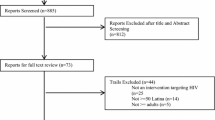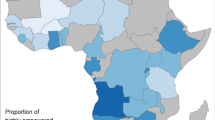Abstract
This preliminary study explored relationships between women's empowerment and HIV prevention on the national and individual level with a focus on Botswana. Among sub-Saharan Africa countries, HIV prevalence was positively correlated with indirect indicators of women's empowerment relating to their education (female enrollment in secondary education and ratio of female to male secondary school enrollment), but not to their economic status (female share of paid employment in industry and services) or political status (women's share of seats in national parliament), while controlling for gross national income, percentage of births attended, and percentage of roads paved. Condom use at last sexual encounter was positively and significantly correlated with both indicators of women's educational empowerment, but was not significantly related to the other two indices. Empowerment at the individual level was explored through a preliminary quantitative survey of 71 sexually active women in Gaborone, Botswana, that was conducted in February 2001. Regression analyses showed that women's negotiating power and economic independence were the factors most strongly related to condom use, and did not show that education was a crucial factor. Economic independence was the factor most strongly related to negotiating power. These results suggest that in Botswana, HIV prevention efforts may need to improve women's negotiating skills and access to income-generating activities.
Similar content being viewed by others

References
Abdool, Q., and Karim. (2001). Barriers to preventing human immunodeficiency virus in women: Experiences from KwaZulu-Natal, South Africa. Journal of the American Medical Women's Association, 56, 193-196.
Agadjanian, V. (1998). Economic security, informational resources, and women's reproductive choices in urban Mozambique. Social Biology, 45, 60-79.
Agha, S. (1998). Sexual activity and condom use in Lusaka, Zambia. International Family Planning Perspectives, 24, 32-37.
Ahlberg, B. M., Jylkas, E., and Krantz, I. (2001). Gendered construction of sexual risks: Implications for safer sex among young people in Kenya and Sweden. Reproductive Health Matters, 9, 26-36.
BIDPA. (2000). Botswana human development report 2000: Towards an AIDS free generation. Gaborone, Botswana: United Nations Development Program and Botswana Institute for Development Policy Analysis.
Blanc, A. K. (1996). Negotiating reproductive outcomes in Uganda. Calverton, MD: Macro International.
Blanc, A. K. (2001). The effect of power in sexual relationships on sexual and reproductive health: An examination of the evidence. Studies in Family Planning, 32, 189-213.
Bosompra, K. (2001). Determinants of condom use intentions of university students in Ghana: An application of the theory of reasoned action. Social Science and Medicine, 52, 1057-1069.
Central Intelligence Agency. (2001). The World Factbook 2001. Retrieved 26 February 2002 from http://www.cia.gov/cia/publications/factbook/.
Dixon-Mueller, R. (1993). Population policy and women's rights: Transforming reproductive choice. Westport, CT: Praeger.
Govindasamy, P., and Malhotra, A. (1996). Women's position and family planning in Egypt. Studies in Family Planning, 27, 328-340.
Greig, F. (2001). Women's empowerment and HIV prevention in Botswana. Stanford University, Stanford, CA.
Gupta, G. R., Weiss, E., and Whelan, D. (1996). HIV/AIDS among women. In J. M. Mann and D. J. M. Tarantola, (Eds.), AIDS in the world II (pp. 215-228). New York: Oxford University Press.
Hogan, D. P., Berhanu, B., and Hailemarium, A. (1999). Household organization, women's autonomy, and contraceptive behavior in southern Ethiopia. Studies in Family Planning, 30, 302-314.
Jefferis, K. (1996). Poverty in Botswana. In D. Nteta, J. Hermans, and P. Jeskova (Eds.), Poverty and plenty: The botswana experience (pp. 50-52). Gaborone, Botswana: The Botswana Society.
Kabeer, N. (1994). Reversed realities: Gender hierarchies in development thought. New York: Verso.
Kapileni, E. (2000). Health and disease in southern Africa: A comparative and vulnerability perspective. Social Science and Medicine, 50, 965-983.
Kishor, S., and Neitzel, K. (1996). The status of women: Indicators for twenty-five countries. Calverton, MD. Macro International.
Koopman, C., and Reid, H. (1998). Assessment of knowledge and beliefs about HIV/AIDS among adolescents. In C. M. Davis, W. L. Yarber, R. Bauserman, G. Schreer, and S. L. Davis (Eds.), Handbook of sexuality-related measures. Thousand Oaks, CA: Sage.
Koss, M. (2001). Koss questionnaire. Unpublished.
Lagarde, E., Carael, M., Glynn, J. R., Kanhonou, L., Abega, S. C., Kahindo, M., Musonda, R., Auvert, B., and Buve, A. (2001). Educational level is associated with condom use within non-spousal partnerships in four cities of sub-Saharan Africa. AIDS, 15, 1399-1408.
Levant, R. F., and Fischer, J. (1996). Masculinity ideology: A comparison between U.S. and Chinese young men and women. Journal of Gender, Culture, and Health, 1, 217-220.
Loewenson, R., and Whiteside, A. (1997). Social and economic Issues of HIV/AIDS in Southern Africa (SAfAIDS Occasional Paper Series). Harare, Zimbabwe: SAfAIDS.
Lutalo, T., Kidugavu, M., Wawer, M. J., Serwadda, D., Zabin, L. S., and Gray, R. H. (2000). Trends and determinants of contraceptive use in Rakai District, Uganda, 1995–98. Studies in Family Planning, 31, 217-227.
Mason, K. O. (1993). The impact of women's position on demographic change during the course of development. In N. Federici, K. O. Mason, and S. Sogner (Eds.), Women's position and demographic change (pp. 19-42). Oxford: Oxford University Press.
Mason, K. O., and Smith, H. L. (1999, March 9). Female autonomy and fertility in five Asian countries. Paper presented at the Annual Meeting of the Populations Association of America, New York.
McIntosh, C. A., and Finkle, J. L. (1995). The Cairo conference on population and development: A new paradigm. Population and Development Review, 21, 223-260.
Measure DHS+ (2002). Demographic and Health Survey Indicators Stat Compiler. Retrieved 26 February 2002 from http://www.measurehs.com/data/indicators/start.cfm?action=new_table&useried=79634&usertabid=88879&CFID=447572&CFTOKEN=35737661.
Mill, J. E., and Anarfi, J. K. (2002). HIV risk environment for Ghanaian women: Challenges to prevention. Social Science and Medicine, 54, 325-337.
Misovich, S. J., Fisher, W. A., and Fisher, J. D. (1997). A measure of AIDS prevention information, motivation, behavioral skills, and behavior. In C. M. Davis, W. L. Yarber, R. Bauserman, G. Schreer, and S. L. Davis (Eds.), Sexuality related measures: A compendium (pp. 328-337). Thousand Oaks, CA: Sage.
Mnyika, K. S., Klepp, K. I., Kvale, G., and Ole-Kingori, N. (1997). Determinants of high-risk sexual behaviour and condom use among adults in the Arusha region, Tanzania. International Journal of STD and AIDS, 8, 176-183.
Muehlenhard, C. L., and Quackenbush, D. M. (1998). Sexual double standard scale. In C. M. Davis, W. L. Yarber, R. Bauserman, G. Schreer, and S. L. Davis (Eds.), Handbook of sexuality-related measures (pp. 186-188). Thousand Oaks, CA: Sage.
Oxaal, Z., and Baden, S. (1997). Gender and empowerment: Definitions, approaches and implications for policy. Institute of Development Studies.
Population Reference Bureau. (2002). DataFinder. Retrieved 20 January 2003 from http://www.worldpop.org/datafinder.htm.
Reddy, P., Meyer-Weitz, A., van den Borne, B., and Kok, G. (2000). Determinants of condom-use behaviour among STD clinic attenders in South Africa. International Journal of STD and AIDS, 11, 521-530.
Republic of Botswana. (1991). Population and Housing Census. Administrative/Technical Report and National Statistical Tables. Gaborone, Botswana: Central Statistical Office.
Republic of Botswana. (1996). Botswana Family Health Survey III. Gaborone, Botswana: Central Statistics Office.
Rodriguez, M. B. (2001). Questionnaire. Unpublished, Stanford, CA.
Schapera, I. (1994). A handbook of Tswana law and custom. Gaborone, Botswana: The Botswana Society.
Shapiro, D., and Tambashe, B. O. (1994). The impact of women's employment and education on contraceptive use and abortion in Kinshasa, Zaire. Studies in Family Planning, 25, 96-110.
Shapiro, D., and Tambashe, B. O. (1997). Education, employment, and fertility in Kinshasa and prospects for changes in reproductive behavior. Population Research and Policy Review, 16, 259-287.
Smith, H. L. (1989). Integrating theory and research on the institutional determinants of fertility. Demography, 26, 171-184.
UNAIDS. (1999). Gender and HIV/AIDS: Taking stock of research and programmes. Geneva: Author.
UNAIDS. (2000a). Gender and HIV. Retrieved 23 February 2002 from http://www.unaids.org/fact_–sheets/files/GenderFS_–en.pdf.
UNAIDS. (2000b). Report on the global HIV/AIDS epidemic. Geneva: Author.
UNAIDS. (2001a). Epidemiological Fact Sheets on HIV/AIDS and Sexually Transmitted Infections 2001 Update. Geneva: UNAIDS and WHO.
UNAIDS. (2001b). HIV/AIDS and human rights (Special session of the General Assembly on HIV/AIDS: Round table 2, Vol. A/S-26/RT.2). Geneva: Author.
UNAIDS. (2002). Epidemiological Fact Sheets on HIV/AIDS and sexually transmitted infections 2002 Update. Geneva: UNAIDS and WHO.
UNCHS. (2001). Women and Urban Governance. Nairobi: United Nations Centre for Human Settlements (Habitat).
UNICEF. (2001). UNICEF Global Database–Skilled Attendant at Deliver. Retrieved 26 February 2002 from http://www.childinfo.org/eddb/maternal/database1.htm.
UNIFEM. (2000). Progress of the World's Women 2000, UNIFEM Biennial Report. New York: Author.
Volk, J. E., and Koopman, C. (2001). Factors associated with condom use in Kenya: A test of the health belief model. AIDS Education and Prevention, 13, 495-508.
World Bank. (1999a). Confronting AIDS. Retrieved 23 February 2001 from http://www.worldbank.org/aids-econ/confront/confrontfull/index.html.
World Bank. (1999b). Intensifying action against HIV/AIDS in Africa. Washington, DC: World Bank, Africa Region.
World Bank. (2001). World development indicators. Retrieved 26 February 2002 from http://www.worldbank.org/data/.
Author information
Authors and Affiliations
Rights and permissions
About this article
Cite this article
Greig, F.E., Koopman, C. Multilevel Analysis of Women's Empowerment and HIV Prevention: Quantitative Survey Results from a Preliminary Study in Botswana. AIDS Behav 7, 195–208 (2003). https://doi.org/10.1023/A:1023954526639
Issue Date:
DOI: https://doi.org/10.1023/A:1023954526639



